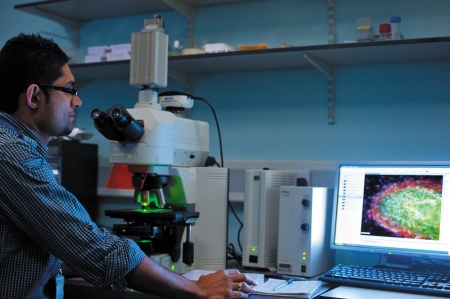
September 25, 2019, by Aleisha Turner
Simulating drug-induced changes in an easy to deploy software service
Containerising and scaling applications using Kubernetes and Azure
Dr Gary Mirams is a Wellcome Trust Senior Research Fellow and member of the Centre for Mathematical Medicine & Biology (CMMB) in the School of Mathematical Sciences, where he constructs mathematical and computational models to describe biological processes.
Mathematical models offer a way to describe the evolution of a heart cell’s electrical activity due to the interaction of the different ionic currents. The heart’s pumping action is driven by the flow of these electrically charged particles, which can be blocked by pharmaceutical compounds. Gary has developed ApPredict – free open source software to enable non-mathematicians/modellers to perform these simulations. However, installing and configuring a suitable software environment for ApPredict is a complex task relying on a specific operating system and software dependencies, resulting in the development of ApPortal – a web-based interface to a pre-existing, shared instance of ApPredict. The challenge was to maximise use of the software by making it available in a form that can be easily and quickly deployed by UoN as a scalable service for others, or as a private service within external organisations such as pharmaceutical companies.
The Response
Gary employed Geoff Williams, a software engineer, to rethink the way ApPredict can be deployed to improve its compatibility with software environments, maximise its scalability, and remove the need for Gary to provide technical support during the deployment process.
Geoff took an approach now common in industry, and carried out an “exercise in separating out what needs and can be scaled”, placing these components into a collection of containers (virtual operating systems). Containers can be run on a much wider variety of hardware, providing greater flexibility about where ApPredict might be deployed. Recognising that releasing a usable service is “not just putting things in containers”, Geoff then developed a proof-of-concept using Kubernetes – an open-source container-orchestration system – to demonstrate how a group of complimentary applications (including ApPredict and ApPortal) can be automatically deployed, scaled and destroyed without server management expertise. Gary and Geoff are now continuing to document the Kubernetes version of the ApPredict suite to allow its release.
Digital Research Service used: High Performance Cloud Computing via Azure Kubernetes Service (AKS)
How Digital Research has made a difference
1)ApPredict can be deployed on any cloud or local hardware that supports Kubernetes, a much wider selection than the non-containerised version (currently Ubuntu only if using a package manger). Enables the possibility for UoN to run ApPredict as a service on Azure forminternal/external users, and external parties to deploy their own instances if necessary (e.g. private instances).
2) Greater scope for scaling the cluster or individual ApPredict containers based on needs of specific use cases, making ApPredict more cost-effective in terms of computing infrastructure for anyone hosting the software.
3) Simplified installation process, requiring little to no server management expertise, reducing burden on Gary to provide technical support to external parties wishing to deploy the software.
4) Geoff and Gary gained practical experience of use of AKS and feasibility of containerising mathematical models/simulations as an approach for other research and impact projects.
No comments yet, fill out a comment to be the first

Leave a Reply